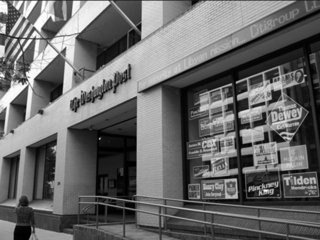Digital health funding declines for the third year in a row
AI-enabled digital health startups raised $3.7B, 37% of total funding for the sector
Read more...
And now, for your daily update in Stuff We Didn't Expect: Amazon CEO Jeff Bezos is the proud new owner of the eighth largest newspaper in the country.
The Washington Post announced Monday that Bezos has shelled out $250 million of his own money in cash for the 136-year-old paper. Yup. The Washington Post - awarded almost 50 Pulitzer Prizes and credited with the breaking of the Watergate scandal under President Nixon 40 years ago - just sold for approximately one-quarter of what Google reportedly paid for GPS navigation app Waze.
Amazon is not involved in the transaction and Bezos is the sole owner of the paper. The Washington Post Company also owns Kaplan, six local TV stations, Cable ONE (a cable provider for Midwestern, western, and southern states), and several other digital businesses, such as Trove and Social Code. The company, which has been owned by the Graham family since 1933, will change to a still-undecided name and will continue to operate as a public company without the Washington Post newspaper.
There won’t be any layoffs, and Jeff Bezos won’t be leaving his stomping grounds in Seattle to manage the paper. Instead, he’ll leave the running of the paper to the existing management. Post publisher Katherine Weymouth, owner Don Graham’s niece, will stay on as publisher, as will executive editor Martin Baron. Bezos and Graham insist that operations at the newspaper will not change after the sale.
“There would be change with or without new ownership. But the key thing I hope people will take away from this is that the values of The Post do not need changing. The duty of the paper is to the readers, not the owners,” said Jeff Bezos to the Washington Post.
The move comes as a shock to many, since it wasn’t widely known that the Post was up for sale. Don Graham secretly hired investment firm Allen & Co. to shop the paper around. Graham and Bezos have been longtime friends and Graham reportedly advised Bezos on how to feature newspapers on the Kindle.
The Post Company shares jumped 5.34% in after-hours trading to $599.
The paper, like so many others, has been struggling to maintain subscriber numbers. The Post Company’s newspaper division, of which The Washington Post is the main component, has seen a 44% decline in operation revenue over the past six years. And during the first half of 2013, daily and Sunday print circulation has fallen another 7%.
In an effort to stem the flow of hemorrhaging money, the Washington Post erected a paywall in June. Readers can access 20 articles a month for free, and after that they have to pay a subscription fee starting at $9.99 a month. The Washington Post came to the paywall game later than others. The Wall Street Journal put up its paywall in 2009 and ended up increasing circulation at a time when most papers were floundering. Similarly, the New York Times erected its paywall in 2011 and claims that paid subscriptions rose 13% between the third and fourth quarters of 2012.
Newspapers have been struggling to stay afloat. In May, The Canadian Journalism Project looked at 60 years of newspaper circulation numbers in Canada, the U.S., and Great Britain and concluded that print is en route to extinction. In the U.S., circulation of paid dailies dropped from 120% of households in 1950 to 40% in 2010.
The Alliance for Audited Media revealed last April in its semiannual report that daily circulation declined by another 0.7% while Sunday circulation declined by 1.4%. Meanwhile, digital news consumption is growing. Digital editions now account for 19.3% of total U.S. news circulation, compared to 14.2% in 2012.
Jeff Bezos admits he doesn’t have a plan worked out yet, but it will be interesting to see what he ends up doing.
Image source: aim.org
AI-enabled digital health startups raised $3.7B, 37% of total funding for the sector
Read more...OXcan combines proteomics and artificial intelligence for early detection
Read more...Nearly $265B in claims are denied every year because of the way they're coded
Read more...
